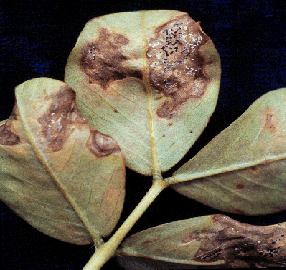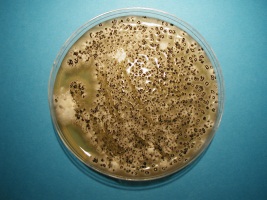Myrothecium, nematodes look out!
- Posted on: November 21, 2010


- Myrothecium from moldlab.com library
Myrothecium is a type of mold spore that we come across every once in a while in air samples, and have had a few clients ask questions about it. Naturally, we directed our search to our in house reference materials first, but they didn’t yield much information. Next, we decided to go online and see what we could come up with.
Here is what we know, or found out about Myrothecium (1):
1). It is a plant pathogen
2). It is common throughout the world
3). It grows on many materials such as paper, textiles, cotton, plants and grass
4). Some species are reported to produce toxin
Of the various species (trivia: do you happen to know how many species of myrothecium there are? see below for answer) of Myrothecium, two are reported to produce the mycotoxin trichothecene: Verrucarines M. and Roridnins M.(1)
Trichothecene is among a very large family of mycotoxins produced by various species of mold including but not limited to: Fusarium, Trichoderma, Trichothecium, Cephalosporium, Verticimonosporium, and Stachybotrys. It is important to note that although Myrothecium can produce toxin there are no reports of human infections.(1)
Interestingly, although Myrothecium is a plant pathogen, it has also been used effectively as a pesticide. As a plant pathogen it has been used to kill weeds, but it is now also used to kill parasitic microscopic pests called Nematodes. (1,3)
On a side note: if you do any type of gardening or organic gardening in particular you might balk at the thought of killing nematodes. Rest assured, in case you aren’t aware, there are actually both good and bad nematodes. The bad nematodes attack plants at the root in crop fields and in particular Red Raspberry fields.(3) However there are good, beneficial nematodes out there. In fact, certain nematodes are actually sold in green nurseries as a natural way of controlling grubs (trust me I know the serious damage grubs cause and am currently trying the nematode control method). Whether the myrothecium pesticide kills all nematodes or only the bad guys I’m not sure.
Using myrothecium as a pesticide involves processing the substance by grinding it into a powder and appling directly to soil or used in a spray application. Due to the nature of these toxins used in pesticide form, application is not allowed near large bodies of water.(1) Another study showed that people who use or process the pesticide reported slight skin and eye irritation but showed no long term effects.(1)
Above are images from our moldlab library of myrothecium growing in the lab setting. Also, we found an image of what is commonly referred to as leaf blight /a plant infected with myrothecium mold that you will see at the top of this blog post.
Have you run across any studies about myrothecium? If so, please share.
Sources:
1). en.wikipedia.org/wiki/Myrothecium_verrucaria
2). icrisat.org -leaf blight pic
3). ddr.nal.usda.gov/handle/10113/37619 research report
4). www.speciesfungorium.org/names/names.asp
Trivia Answer: There are reported to be approximately 21 different species of Myrothecium(4)



